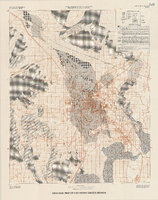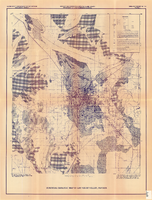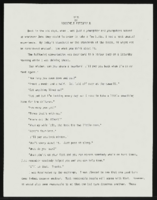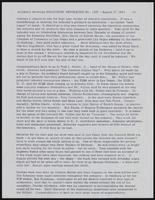Search the Special Collections and Archives Portal
Search Results

Transcript of interview with Willie Jones, James Jones, and Jamet Jones by Robbin Mc Laurin, March 5, 1980
Date
Archival Collection
Description
On March 5, 1980, collector Robbin McLaurin interviews three members of the Jones family, Willie, James, and Jamet Jones (born 1923, 1920, and 1961, respectively) in the Jones home. Mr. and Mrs. Jones were born in Forest, Mississippi, and relocated to Las Vegas, Nevada, for employment related purposes. This interview covers Las Vegas, past and present.
Text

Transcript of interview with Dale Duane Everett by John Everett, March 7, 1980
Date
Archival Collection
Description
On March 7, 1980, John Everett interviewed his father, cab driver Dale Everett (born January 29, 1924 in Danville, Illinois) at their family home in Las Vegas, Nevada. This interview covers past local historical data. During the interview, Mr. Everett discusses the weather, wildlife, and hunting. He also shares his views on prostitution and gambling in Las Vegas.
Text

Geologic map of Las Vegas Valley, Nevada, 1982
Date
Description
Image

Surficial geologic map of Las Vegas Valley, Nevada, circa 1981
Date
Description
Image
Kent Carmichael oral history interview
Identifier
Abstract
Oral history interview with Kent Carmichael conducted by Stefani Evans on November 25 and December 2, 2019 for the Boyer Early Las Vegas Oral History Project.
In the first session of this oral history, Carmichael discusses his early career in lighting design and maintenance from his start at Interstate Neon to his work in the 1950s and 60s in Las Vegas. He discusses some of the iconic signs he built including the Casino Center, Carnival Room, Thunderbird, The Frontier, Bonanza, and the Stardust. He also details the technology and inner workings of these innovative signs including the transition from mechanical to electrically controlled signage. Carmichael continues to discuss Native American laborers and various individuals that he interacted with throughout his early career including Max and Mo Oggenblick, Doby Doc, Benny Binion, Arby Alper, Steve Wynn, Peter Arp, and Wayne and Jerry Newton. Carmichael ends the first interview by recalling a high wind event that damaged the Frontier sign and his efforts to bring the sign under control and repair it as well as his vision and behind the Stardust sign.
The second oral history interview contains Carmichael’s discussion of his career from 1968 onward. He immediately picks up discussion of the Stardust sign and his transition to desk work. Carmichael details the challenge and limitations of designing the International sign (the Westgate as of 2021). He describes the development of his first messenger sign for the International and the time consuming task of using tape to program the sign. He fondly remembers working on the Holiday Inn Riverboat signs, and International transition to Las Vegas Hilton and the Hilton’s transition from blue to red letters. Carmichael shares the story of being caught between organized crime and a young Steve Wynn. He recounts his last project for Ad Art, developing and construction the sign for the Louisiana Superdome in New Orleans, Louisiana. He details working through legislative and construction issues as well as the fallout from the Nat Kiefer Commission.
After leaving Ad Art Carmichael began working with Heath and Co. and began collaborating with Raul Rodriguez. Carmichael and Rodriguez went on to design some of the most enduring and visually unique signs in Las Vegas including, the Flamingo, Four Queens, Golden Nugget, Dunes Hotel, and the Desert Inn. They also worked in Reno on Circus Circus and El Dorado. Carmichael also details his interior work including the main pylon and interior signs for MGM Grand; 1974 renovation Golden Nugget, suspended stained glass ceiling at Tropicana, and the MGM Lion display. Lastly Carmichael outlined his work with Young Electric Sign 1983-85 and the Dewey Sign Company including the Las Vegas Convention Center sign. He ends by sharing his views on the role and importance of lighting in Las Vegas.
Archival Collection

Transcript of interview with Mary Ellen Campbell by Ronald Robinson, March 6, 1977
Date
Description
On March 6, 1977, Ronald Robinson interviewed Mary Ellen Campbell (born 1886 in Panaca, Nevada) about her life in Nevada. Campbell first talks about her parents’ move to the United States from England and her own life growing up in Panaca. She also talks about living in Pioche and the conditions of living in these two small Nevada towns. Also present during the interview is Mary’s grandson, Allen Campbell, who sometimes asks a few questions as well.
Text

"Reds": article draft by Roosevelt Fitzgerald
Date
Archival Collection
Description
From the Roosevelt Fitzgerald Professional Papers (MS-01082) -- Drafts for the Las Vegas Sentinel Voice file. On Americans welcoming Russians with VIP treatment, while minorities continue to be mistreated.
Text



